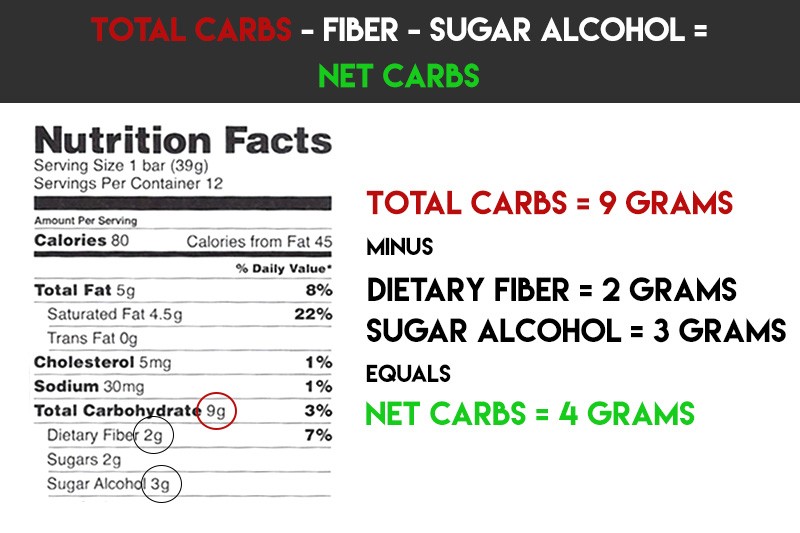Each person’s body reacts differently to the nutrients we consume and use to fuel ourselves. Often, low-carb dieters who want to lead healthy lifestyles and promote long-term health look for the right balance; that begins with understanding what a carbohydrate is.
Carbohydrates, or carbs, are macronutrients that our bodies convert to glucose. We use glucose for fuel, and if we consume more carbs than we need, they are stored as glycogen in the liver and muscles for future use. Overconsumption of carbs raises blood sugar, which increases insulin levels and leads to insulin spikes. Spikes in insulin inhibit the breakdown of fat in adipose tissue and stimulates the creation of more fat storage. Followers of low-carb and ketogenic diets aim to maintain nutritional balance and not subject their bodies to such spikes. Dieters count their macronutrients, not their daily calories, to achieve nutritional balance, but what counts when counting carbohydrates: net or total carbs?
People who follow a low-carb meal plan count their macronutrients in grams. Fats and proteins are easy to calculate based on the nutrition labels on food, but carbs are a little more complicated. The main difference begins with net carbs vs. total carbs.
4-Week Keto Meal Plan
- 4 Weeks of Delicious Keto Recipes!
- Leftovers and Bulk Preps Included
- Maximize Your Keto Diet's Success

Net Carbs vs. Total Carbs

Net carbs are the total carbohydrates consumed minus all carbs derived from fiber and other non-digestible carbs referred to as the “other carbs.” Sugar alcohols, such as erythritol, sorbitol, and xylitol, are classified as other carbs. The sugar alcohol role in glucose production is more unpredictable but it also has a far less dramatic effect on the body than sugars and starches, and when consumed in moderation, sugar alcohols can be a substitute for sugar1.
When it comes to low-carb dieting, many people chose to count their net carbs over their total carbs because the liver does not convert carbs from fiber and other non-digestible carbs to glucose as sugars and starches. Fiber is made up plant material, such as cellulose, that is further classified as insoluble and soluble. As a plant material, it is not digestible by the body in the same way as fats and proteins. However, soluble fiber can convert to glucose by microbiota fermentation in the gut where it is stored in the intestines. This process is known as intestinal gluconeogenesis (IGN), and the glucose here differs from hepatic, or liver glucose.
Previously, it was believed the IGN process raised blood sugar levels because of the increased glucose converted in the intestines. For this reason, some dieters chose to count the total carbs rather than the net carbs. However, studies now indicate intestinal glucose lowers and helps manage blood sugar levels and insulin tolerance so that people can achieve glucose homeostasis and promote ketosis2. Fiber also helps signal hunger satiation because it stimulates certain hormone production that behaves like a natural appetite suppressor.
Studies show that soluble dietary fiber plays a pivotal role in achieving stabilized insulin levels and suppressing appetites; both benefits can significantly aid dieters with energy and weight management3. For this reason, people practicing low-carb, keto dieting should consider calculating their net carbs rather than their total. Net carb calculation will also help people stay conscientious on the amount of dietary fiber they consume as well as the “other carbs.”
Soluble fibers come from a variety of foods such as broccoli, lentils, black beans, bran flakes, raspberries, avocados, and many more. Nutrition and how the body reacts to changes in macronutrients varies because our bodies are unique to us. For that reason, considering the net carb count is a better choice for people who want to achieve ketosis.
The key to leading a healthy life through low carb dieting is about understanding how macronutrients affect your body and being able to make personal adjustments to all types of carbohydrates, such as sugar, starch, fiber, and sugar alcohols to achieve your goals. Therefore, calculating your net carbs has far more advantage than assigning a total carb macro goal.
To calculate your net carbs, the first thing you should do is subtract all of the carbs from fiber (generally listed under “Dietary Fiber” on American food labels) from total carbs. This is just a start: nutrition labels aren’t always entirely accurate, and it’s not uncommon for fiber to not be listed. The best long-term solution is to research your favorite foods and find out what percentage of carbs come from fiber.
NUTRITIONAL DISCLAIMER
The content on this website should not be taken as medical advice and you should ALWAYS consult with your doctor before starting any diet or exercise program. We provide nutritional data for our recipes as a courtesy to our readers. We use Total Keto Diet app software to calculate the nutrition and we remove fiber and sugar alcohols, like erythritol, from the total carbohydrate count to get to the net carb count, as they do not affect your blood glucose levels. You should independently calculate nutritional information on your own and not rely on our data. The website or content herein is not intended to cure, prevent, diagnose or treat any disease. This website shall not be liable for adverse reactions or any other outcome resulting from the use of recipes or recommendations on the Website or actions you take as a result. Any action you take is strictly at your own risk.
- Keto-Friendly Food Swaps for Common Ingredients - July 11, 2023
- Keto Diet and Acne: Reducing Breakouts and Promoting Clear Skin - July 9, 2023
- Can the Keto Diet Help with Epilepsy? - July 7, 2023








I don’t like the idea of taking supplements, or sugar substitutes. I’ve been doing this diet without either…I’ve lost slower than most, mainly inches but I’m losing just fine without either.
I think the best thing to do is to count total carbs if you want to maintain a low-carb diet. The net carb concept gets abused by some dishonest producers of low-carb products. They twist and obscure carb counts to create false or exaggerated low-carb claims.Most countries have strict regulations about presenting standard nutritional data. But sadly, not so much when it comes to niche concepts like net carbs. So unscrupulous companies can get away with false claims in this area. This bad practice is especially common when it comes to sugar substitutes, sweets and low-carb bars – casting doubts about the whole notion of net carbs.Some products are indeed sugar-free and low-carb as they claim. But many are not. So we should be very careful with anything that’s marketed as a low-carb alternative to sugar and sugary treats.